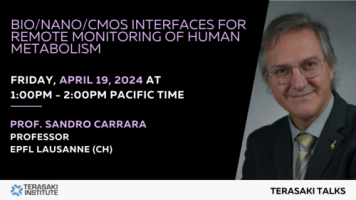Events
Upcoming events
Terasaki Talks Presents: “Bio/Nano/CMOS interfaces for Remote Monitoring of Human Metabolism ”, Presenter: Prof. Sandro Carrara

Abstract
IoT wearable-devices (accelerometers, heartbeat monitoring system, etc) are key devices for better, more rationale, effective and ultimately low-cost health care also at home. However, all these systems do not usually allow measurements of the human metabolism at molecular level (single metabolites). So far, there are no available integrated nano-bio-systems for multi-metabolites, real-time, remote monitoring of the human metabolism. Thus, the aim of this talk is to present innovative concepts for multi-panel, highly integrated, fully implantable, remotely powered and real-time monitoring systems for human metabolism at molecular level. Applications are shown in the field of implantable and wearable devices, with in-vivo experiments too, and addressing issues about biocompatible-packaging, flexible electronics, and monitoring-needs in intensive care units. Future perspective on injectable Body Dust devices are addressed as well.
